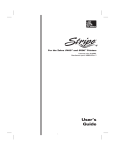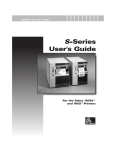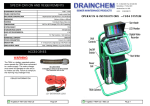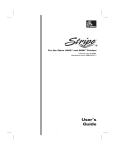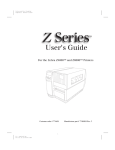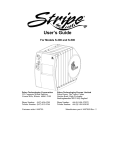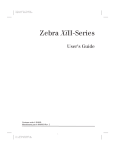Download Zebra A300 User`s guide
Transcript
ZEBRA PERSONAL PRINTER LINE 333 Corporate Woods Parkway Vernon Hills, Illinois 60061.3109 USA Telephone +1 847.634.6700 Facsimile +1 847.913.8766 Zebra A300 DIRECT THERMAL PRINTER Zebra Technologies Europe Limited Zebra House The Valley Centre, Gordon Road High Wycombe Buckinghamshire HP13 6EQ, UK Telephone +44 (0)1494 472872 Facsimile +44 (0)1494 450103 User's Guide Customer order #55530L Manufacturer part #55530LB © Zebra Technologies Corporation 55530lr4 Page -3 Wednesday, March 26, 1997 11:18 AM Zebra A300 ® User’s Guide Customer order # 55530L Manufacturer part # 55530LB Rev. 4 55530lr4 Page -2 Wednesday, March 26, 1997 11:18 AM Zebra A300 Users Guide Proprietary Statement This manual contains proprietary information of Zebra Technologies Corporation. It is intended solely for the information and use of parties operating and maintaining the equipment described herein. Such proprietary information may not be used, reproduced, or disclosed to any other parties for any other purpose without the expressed written permission of Zebra Technologies Corporation. Product Improvements Continuous improvement of products is a policy of Zebra Technologies Corporation. All specifications and signs are subject to change without notice. FCC Compliance Statement Note: This equipment has been tested and found to comply with the limits for a Class A digital Device, pursuant to Part 15 of the FCC Rules. These limits are designed to provide reasonable protection against harmful interference when the equipment is operated in a commercial environment. This equipment generates, uses and can radiate radio frequency energy and, if not installed and used in accordance with the instructions manual, may cause harmful interference to radio communications. Operation of this equipment in a residential area is likely to cause harmful interference in which case the user will be required to correct the interference at his own expense. In order to insure compliance, this printer must be used with Shielded Communication Cables. “The user is cautioned that any changes or modifications not expressly approved by Zebra Technologies Corporation could void the user’s authority to operate the equipment.” Canadian DOC Compliance Statement This digital apparatus does not exceed the Class A limits for radio noise emissions from digital apparatus as set out in the radio interference regulations of the Canadian Department of Communications. CE Compliance If the accompanying printer displays the CE mark, it also meets EMC directive 89/336/EEC, with ammendments effective at the time of manufacture. Liability Disclaimer Zebra Technologies Corporation takes steps to assure that its published Engineering specifications and Manuals are correct; however, errors do occur. Zebra Technologies Corporation has been advised of the possibility of such damages. Because some states do not allow the exclusion or limitation of liability for consequential or incidental damages, the above limitation may not apply to you. Copyrights This copyrighted manual and the label printer described herein are owned by Zebra Technologies Corporation. All rights are reserved. Unauthorized reproduction of this manual or the software in the label printer may result in imprisonment of up to one year and fines of up to $10,000 (17 U.S.C.506). Copyright violators may be subject to civil liability. All trademarks are the property of their respective owners. Zebra, ZPL, and ZPL II are registered trademarks and ZebraNet is a trademark of Zebra Technologies Corporation. Centronics is a registered trademark of Centronics Data Computer Corporation. Windows is a trademark of Microsoft Corporation. IBM is a registered trademark of International Business Machines Corp. © Zebra Technologies Corporation. All rights reserved. 55530lr4 Page -1 Wednesday, March 26, 1997 11:18 AM Zebra A300 Users Guide Contents Introduction . . . . . . . . . . . . . . . . . . . . . . . . . . . . . . . . . . . . . . . . . . . . . . . . . . 1 Unpacking and Inspection . . . . . . . . . . . . . . . . . . . . . . . . . . . . . . . . . . . . . . . 1 Additional Requirements. . . . . . . . . . . . . . . . . . . . . . . . . . . . . . . . . . . . . . . . 1 Setting Up the Zebra A300 Printer . . . . . . . . . . . . . . . . . . . . . . . . . . . . . . . . 2 Setting Up the Software . . . . . . . . . . . . . . . . . . . . . . . . . . . . . . . . . . . . . . . 12 Operating the System . . . . . . . . . . . . . . . . . . . . . . . . . . . . . . . . . . . . . . . . . 13 ZebraNet Option . . . . . . . . . . . . . . . . . . . . . . . . . . . . . . . . . . . . . . . . . . . . . 17 Preventive Maintenance . . . . . . . . . . . . . . . . . . . . . . . . . . . . . . . . . . . . . . . 18 Troubleshooting. . . . . . . . . . . . . . . . . . . . . . . . . . . . . . . . . . . . . . . . . . . . . . 19 Specifications . . . . . . . . . . . . . . . . . . . . . . . . . . . . . . . . . . . . . . . . . . . . . . . 22 Software License Agreement . . . . . . . . . . . . . . . . . . . . . . . . . . . . . . . . . . . 25 Warranty . . . . . . . . . . . . . . . . . . . . . . . . . . . . . . . . . . . . . . . . . . . . . . . . . . . 26 i 55530lr4 Page 0 Wednesday, March 26, 1997 11:18 AM Zebra A300 Users Guide 1 2 3 4 5 3 6 14 13 12 11 10 7 6 8 9 1 2 3 4 5 6 7 Media cover Media holder Media guides Tear bar Printhead Print mechanism latches Peel-off roller 8 Peel-off door latches 9 Platen roller 10 Power/fault lights 11 Feed button 12 Printhead open sensor 13 Paper out sensor 14 Label presentation sensor Figure 1: Printer Overview ii 55530lr4 Page 1 Wednesday, March 26, 1997 11:18 AM Zebra A300 Users Guide Introduction This manual provides all of the information you will need to operate your printer on a daily basis. To print labels, tags, or tickets with the A300 printer, refer to the ZPL II Programming Guide (part # 46469L) or to the on-line instructions with the BAR-ONE software. To obtain a copy of the ZPL II Programming Guide, mail or fax in the card at the back of this book. Unpacking and Inspection Save the carton and all packing materials in case shipping is ever required. Inspect the printer for possible damage incurred during shipment. If you discover shipping damage upon inspection: • • • Immediately notify the shipping company of the damage. Retain all packaging material for shipping company inspection. File a damage report with the shipping company and notify your local distributor and Zebra Technologies Corporation of the damage. Zebra Technologies Corporation is not responsible for any damage incurred during shipment of the equipment and will not repair this damage under warranty. Immediate notification of damage to the shipping company or its insuring agency will generally result in ensuring any damage claim validity and ultimate monetary compensation. Additional Requirements • • • Shielded data cable—serial or parallel, depending on which method you prefer to use. Power cord—for 230 VAC operation only (120 VAC units come with a power cord) ZPL II Programming Guide, if you are going to use ZPL II to design label formats for the A300 printer. To obtain a copy, mail or fax in the card at the back of this book. 1 55530lr4 Page 2 Wednesday, March 26, 1997 11:18 AM Zebra A300 Users Guide Setting Up the Zebra A300 Printer Tear-Off Mode of Operation 1 2 2 55530lr4 Page 3 Wednesday, March 26, 1997 11:18 AM Zebra A300 Users Guide 3 4 3 55530lr4 Page 4 Wednesday, March 26, 1997 11:18 AM Zebra A300 Users Guide 5 1 2 6 7 4 3 55530lr4 Page 5 Wednesday, March 26, 1997 11:18 AM Zebra A300 Users Guide Peel-Off Mode of Operation 1 2 5 55530lr4 Page 6 Wednesday, March 26, 1997 11:18 AM Zebra A300 Users Guide 3 4 6 55530lr4 Page 7 Wednesday, March 26, 1997 11:18 AM Zebra A300 Users Guide 5 1 2 3 6 7 55530lr4 Page 8 Wednesday, March 26, 1997 11:18 AM Zebra A300 Users Guide 7 8 8 55530lr4 Page 9 Wednesday, March 26, 1997 11:18 AM Zebra A300 Users Guide Fanfold Media Loading 1 2 9 55530lr4 Page 10 Wednesday, March 26, 1997 11:18 AM Zebra A300 Users Guide A300 Printer to the Computer Figure 2: Parallel Connection Connecting the Zebra 10 55530lr4 Page 11 Wednesday, March 26, 1997 11:18 AM Zebra A300 Users Guide Figure 3: Serial Connection 11 55530lr4 Page 12 Wednesday, March 26, 1997 11:18 AM Zebra A300 Users Guide Setting Up the Software Note: If you plan to use BAR-ONE software to create your labels, you will need to install the software on your computer before you can operate your printer. You will not need to use BAR-ONE software if you are printing label formats created in ZPL II. To print ZPL II, you may use virtually any text program on any computer—including Apple® computers—that will send ASCII text to the printer via either the serial or parallel port. For more information, refer to the ZPL II Programming Guide (available by sending in the mail-in/ fax-in postcard at the back of this book). BAR-ONE System Requirements BAR-ONE software works with most IBM®-compatible personal computers available today. The software may be installed and up-and-running within a few minutes. Refer to the on-line help system and to the Read-Me file for further information and/or last-minute updates. The BAR-ONE software may be installed on any computer that meets the following system requirements: BAR-ONE System Requirements mended Processor 486SX 486SX Hard disk 3 MB 10 MB Memory 4 MB RAM 8 MB RAM Interface RS-232 Parallel Display VGA Floppy drive Operating system Mouse 12 Recom- Minimum SVGA 3½” Windows™ 3.1 or higher, NT, 95; OS/2 RS-232 or PS/2 55530lr4 Page 13 Wednesday, March 26, 1997 11:18 AM Zebra A300 Users Guide BAR-ONE Installation The A300 printer uses BAR-ONE software or ZPL II Programming Language sent from any Windows™ or DOS application. 1. Start Windows. 2. Insert disk 1 of the BAR-ONE software in your floppy disk drive (A: or B:). 3. In Program Manager, click on the File menu. Select Run. (Windows 95 users: select Run from the Start menu.) 4. Type A:\SETUP (or B:\SETUP) and then press OK. 5. Follow the on-screen instructions to complete the installation. Operating the System To create a label for the A300, you may either use the BAR-ONE software to create the label format or write one in ZPL II , which is Zebra’s programming language for creating labels. If you are using BAR-ONE software, refer to the on-line BAR-ONE instructions. If you are using, or plan to use, the ZPL II programming language to format your labels, make sure you have a copy of the ZPL II Programming Guide. Refer to the mail-in/fax-in card included with the A300 printer to obtain a copy, if desired. Printer Operating Modes Tear-Off Mode. The operator tears off each label (or a strip of labels) as it is printed. Peel-Off Mode. The backing material is peeled away from the label as it is printed, the printer waits until the operator removes the label, then the next label prints. 13 55530lr4 Page 14 Wednesday, March 26, 1997 11:18 AM Zebra A300 Users Guide Operator Controls Power Switch. Located on the right-hand side of the printer near the back. The power switch should be turned off before connecting or disconnecting any cables. Feed Key. In normal use, pressing the Feed Key once when the printer is idle (not printing) will cause the printer to feed a blank label. The Feed Key also activates a number of specialized functions which are described in Table 1. Table 1: Feed Key Troubleshooting Modes Power Off Mode (Communications Diagnostics Mode) With the printer power off, press and hold the Feed key while you turn the power on. The printer prints out a listing of its current configuration (configuration label). See Figure 5 on page 20. For best results, use media that is at least 4” wide by 4” long. After printing the label, the printer will automatically enter a diagnostic mode in which the printer prints out a literal representation of all data subsequently received (hex dump mode). To exit this mode, turn the printer power off. Power On Modes With the printer power on, printhead closed, and Fault light off, press and hold the Feed key for several seconds and the Fault Light will flash the following numer of times in sequence. The explanation at the right shows what happens when you release the key after the specific number of flashes. * The label showing the current configuration of the printer prints. For best results, use media that is at least 4” wide by 4” long. See Figure 5 on page 20. ** The media sensor calibration process is entered. See “Calibration” on page 15. *** The serial communication parameters are reset to 9600 baud, 8 bit word length, no parity, and 1 stop bit. **** Reset factory defaults. Once this mode is entered, the Fault light will flash rapidly. If the Feed key is pressed and released at this time, the factory default settings will be saved into memory. If the feed key is held down past 4 flashes, the printer will ignore the key when it is released. 14 Color profile: Disabled Composite Default screen Zebra A300 & T 300 User's Guide Adde ndum 1 C:\A_Series\A_T_Adden.vp Wed Aug 12 10:52:06 1998 Color profile: Disabled Composite Default screen Scope This addendum contains information about the new Calibration features added to the Zebra A300 and Zebra T300 printers when upgraded with the 25.8.1 and 23.8.1 versions of firmware respectively. Calibration Auto-Calibration The printer only auto-calibrates when using non-continuous media (a gap, notch, or black mark separates each label). During this process, the printer sets the sensor levels for, and determines the length of, the labels being used. (To calibrate the printer for media with pre-printed labels or pre-printed backing, see “Manual Calibration.”) The first time the printer is turned ON, auto-calibration senses if continuous media is loaded. If this media is used, the label length must be set through the label preparation software being used. NOTE: If continuous media is sensed, non-continuous media can not be used until you either (a) reset the factory defaults (see “Feed Key Troubleshooting Modes” in the "Operating the System" section of the printer user's guide), or (b) refer to your label preparation software user’s manual. To auto-calibrate: 1. Load the media according to the instructions in “Setting Up the Zebra Printer” in the printer user's guide. 2. Turn the printer power ON. 3. Some blank labels will feed, completing the auto-calibration process. 4. If the Fault LED (A300) or Power LED (T300) begins flashing, refer to the “Manual Calibration” process. Remember: n Auto-calibration is performed when the printer is turned ON and whenever an error condition is cleared. n Single flashing of the A300 Fault LED indicates a PRINTHEAD OPEN condition. Single flashing of the T300 Power LED indicates an Error condition. n Double flashing of the LED (A300 Fault LED - T300 Power LED) indicates a printer PAUSED mode. Press the FEED Button and the printer will auto-calibrate. 2 C:\A_Series\A_T_Adden.vp Wed Aug 12 10:52:07 1998 Color profile: Disabled Composite Default screen Manual Calibration Manual calibration should be performed whenever you are using preprinted labels or preprinted label backing, or if the printer will not auto calibrate. NOTE: Before performing a manual calibration, refer to your label preparation software user’s manual and set the printer for the media type (web or black mark). To manually calibrate: 1. Turn the printer power ON. 2. Remove several labels from a section of backing material. Load 3. 4. 5. 6. the media so that only the backing material is threaded through the printer and under the printhead, then close the printhead. Press and hold the FEED button until the LED (A300 Fault LED - T300 Power LED) flashes once, then twice; then release the button. The printer sets the media sensor for the label backing you are using. (Once this process is completed, the media automatically feeds forward until a label is positioned at the printhead.) A profile of the media sensor settings is printed on the label. (See the examples in Figures 1 and 2). The printer then saves the new settings in memory and is ready for normal operation. Press the Feed button. One entire blank label should feed. If this does not happen, try resetting the factory defaults for the printer (see “Feed Key Troubleshooting Modes” in the "Operating the System" section of the printer user's guide). NOTE: Performing a manual calibration disables the auto-calibration function. To return to auto-calibration, either default the printer (see “Feed Key Troubleshooting Modes” in the "Operating the System" section of the printer user's guide) or refer to your label preparation software user’s manual. 3 C:\A_Series\A_T_Adden.vp Wed Aug 12 10:52:07 1998 Color profile: Disabled Composite Default screen Figure 1. A300 Sample Media Sensor Profile Figure 2. T300 Sample Media Sensor Profile © Zebra Technologies Corporation 4 C:\A_Series\A_T_Adden.vp Wed Aug 12 10:52:07 1998 Part # 55560L Rev. 1 55530lr4 Page 15 Wednesday, March 26, 1997 11:18 AM Zebra A300 Users Guide Printer Indicator Lights. Table 2: Printer Indicator Lights Power Light Fault Light g ni Printer Condition ff n O Power is off or printer not receiving power Power is on Paper out or not sensed or Printhead is open Printhead is over temperature hs O O F • O • • • • • ff la n • • Initial Printer Power-Up Turn the printer on by pressing the Power Switch on the right side of the printer. The Power and Fault lights will turn on. The printer performs a set of internal diagnostics, and after the diagnostics have been completed (within 1 - 10 seconds) the Fault light will turn off. If you are using non-continuous media, the printer will then advance the media to position the gap over the tear bar so that it is ready for use. If loading the printer with media for the first time, or changing the type of media, perform the Calibration below. Calibration This calibration procedure should be performed the first time you use the printer and any time you change the type of media in the printer. 1. Remove several labels from a section of backing material so that only the backing material is under the printhead mechanism. 2. Turn the printer power on if it is not already on. 3. Press and hold the Feed Key until the Fault light flashes twice in a row. (First it will flash once, then twice in a row at which point you release the key.) 4. The printer will adjust the media sensor level for the media backing you are using. After it is done making this adjustment, the Fault light will flash rapidly. 5. Reload the media so that a label is under the printhead. 15 55530lr4 Page 16 Wednesday, March 26, 1997 11:18 AM Zebra A300 Users Guide 6. Press and release the Feed Key. A profile of the media sensor settings will print. When complete, the printer will save the new settings in memory and the printer is ready for normal operation. Figure 4: Sample Media Sensor Profile Setting the Communication Parameters If you are using the printer’s serial port to transfer data, you will need to make sure that the printer and the computer have identical communication parameter settings. To initialize the communication parameters for the printer: • • 16 Press and hold the Feed key until the Fault light blinks three (3) times in a row. Release the key. The baud rate for the printer will be reset to 9600 baud, 8 bit word length, no parity, and 1 stop bit. Then, set the communications parameters on your computer to match this. If you need to use different settings than the defaults (for example, if you are using a modem with certain requirements) you have two options for setting the communications parameters. Send the ^SC “Set Communications” ZPL command (described below) at 9600 baud via the serial port set up as shown above, then reset the computer to the new values. Or, send the ^SC command via the parallel port, then reconnect for serial port operation as needed. 55530lr4 Page 17 Wednesday, March 26, 1997 11:18 AM Zebra A300 Users Guide Here is the command description for the Set Communications command (refer to your ZPL II Programming Guide for additional programming information): ^SCa,b,c,d,e,f where a = baud rate (110 - 19200 baud) b = word length (7 or 8 data bits) c = parity (N = none, E = even, O = odd) d = stop bits (1 or 2 ) e = handshake (X = XON/XOFF, D = DTR/DSR) f = Zebra protocol (Y = yes, N = no) If you do not specify a new setting for a parameter, it remains unchanged (it does not change to the default value). Adjusting the Darkness of the Printing If you are using BAR-ONE or other software, adjust the relative darkness setting as indicated in that software. Or, if you are using ZPL II, send the ^MD (Media Darkness) ZPL II command. ZebraNet Option You may choose to network your Zebra A300 printer. Contact your distributor for information about ZebraNet™ micro print server—ethernet connectivity for your Zebra A300 printer. 17 55530lr4 Page 18 Wednesday, March 26, 1997 11:18 AM Zebra A300 Users Guide Preventive Maintenance Cleaning CAUTION: Use only the cleaning agents indicated in the following table. Zebra Technologies Corporation will not be responsible for any other fluids being used on this printer. Inconsistent print quality, such as voids in the bar code or graphics, may indicate a dirty printhead. For best results, perform the cleaning procedures in Table 4. For the location of these printer parts, refer to Figure 1 on page ii. Table 3. Cleaning Schedule Area Printhead Method Note: You do not need to turn the printer off before cleaning the printhead. Use solvent* on a cotton swab to clean the print elements from end to end. (The print elements are the thin gray line on the printhead.) Platen Roller Rotate the platen roller and clean it thoroughly with solvent* and a cotton swab. Peel-Off Roller Rotate the peel-off roller and clean it thoroughly with solvent* and a cotton swab. Transmissive Media Sensor Air blow Media Path Solvent* Peel/Tear Bar Solvent* Label Available Sensor Air blow Printhead Open Sensor Air blow Exterior Mild detergent or desktop cleaner. Interior Brush/vacuum cleaner * Zebra recommends using solvent containing 70% isopropyl alcohol. Interval After every roll of media (or 500 ft of fanfold media) As needed. Monthly. As needed. As needed. As needed. Lubrication CAUTION! No lubricating agents of any kind should be used on this printer! If used, some commercially available lubricants will damage the finish and mechanical parts. 18 55530lr4 Page 19 Wednesday, March 26, 1997 11:18 AM Zebra A300 Users Guide Troubleshooting Table 4. Troubleshooting Symptom Diagnosis Power light does not turn on when Power switch is turned on. When printer is first powered on, the Fault light remains on. Fault light is flashing. Printer is not receiving Make sure that the power supply is plugged power. into the printer and into a wall outlet, power strip, or other source of power. Printer failed an inter- Turn the printer power off and then back on. nal diagnostic test. If the symptom persists, call a service technician. Printhead is open. Close printhead. Action Out of media or media Load media correctly. Make sure that the incorrectly loaded. media is placed on the inside edge of the platen roller and that it feeds straight through the printhead otherwise it may not be detected by the media sensor. Printhead is overAllow printer to cool. Printing resumes heated. automatically when the printhead element cools to operating temperature. Long tracks of missing Printhead is dirty. Clean the printhead. See Table 3 on page 18. print (blank vertical Print element is dam- Call a service technician to replace the printlines) on several labels. aged. head. Misregistration (print- Printer needs to be Recalibrate the printer. See “Calibration” on ing does not start at the calibrated. page 15. top of the label) and misprint of 1 to 3 labels. A label format was sent Communications For serial communication, make sure that to the printer but not parameters are incor- the baud rates of the printer and the comrecognized. rect. puter match. Also, make sure that the correct com ports on the PC are selected. Data cable not correct Make sure the data cable is installed coror not connected cor- rectly if serially connected. For serial operarectly. tion, make sure you are using a “null modem” cable. Printer appears to oper- Non-thermally sensi- Make sure that you are using direct thermal ate, but nothing prints. tive material. label, ticket, or tag stock. Zebra recommends using genuine Zebra media in your printer for best results. 19 55530lr4 Page 20 Wednesday, March 26, 1997 11:18 AM Zebra A300 Users Guide Troubleshooting Modes Printing a Configuration Label. To print out a listing of the printer’s current configuration (configuration label), refer to Table 1, “Feed Key Troubleshooting Modes,” on page 14. Figure 5: Configuration Label (Sample) Calibration. If the printer is exhibiting unusual symptoms, such as skipping a label, you may need to recalibrate the printer. See “Calibration” on page 15. Resetting to Factory Default Values. Resetting the printer to the factory defaults might solve some problems. For instructions, refer to Table 1, “Feed Key Troubleshooting Modes,” on page 14. Communications Diagnostics. If you suspect problems in transferring data between the computer and printer, you may want to put the printer in the Communications Diagnostics mode. In this mode, the printer prints the ASCII characters and their corresponding hexadecimal values for any data received from the host computer. For instructions, refer to Table 1, “Feed Key Troubleshooting Modes,” on page 14. A typical printout is shown in Figure 6. 20 55530lr4 Page 21 Wednesday, March 26, 1997 11:18 AM Zebra A300 Users Guide Figure 6: Communications Diagnostics Printout (Sample) 21 55530lr4 Page 22 Wednesday, March 26, 1997 11:18 AM Zebra A300 Users Guide Specifications Table 5: Specifications Print density Print width Print speed Label width (including backing material, if any) Label length Interlabel gap Label thickness (including backing material, if any) Label roll size Maximum outer diameter Minimum inner core diameter Registration toler- Horizontal ance Vertical First dot location (from outer media edge) Fonts available Bar codes available 22 203 dots/inch 1² to 4.125² 2²/sec 1² to 4.25² 8 dots/mm 25.6 to 105.0 mm 51 mm/sec 25 to 108 mm 0.5² to 18² 0.08² to 0.16² 0.003² to 0.010² 12.7 to 457 mm 2 to 4 mm 0.076 to 0.254 mm 5.0² 127 mm 1.0² 25.4 mm ± 0.059² ± 0.0393² 0.125² to 0.140² ± 1.5 mm ± 1.0 mm 3.17 to 3.56 mm • CG Triumvirate Bold Condensed (6, 8, 10, 12, 14, 18 pt.) • Zebra fonts A, B, C, D, E, H, GS, IBM Code Page 850 International Characters, Graphics symbols • 2-digit and 5-digit supplemental code • Codabar (Supports ratios of 2:1 to 3:1) • Code 11 • Code 128 (Supports serialization in all subsets and UCC Case Codes) • Code 39 (Supports ratios of 2:1 to 3:1) • Code 93 • EAN Versions 8 and 13, EAN Extensions • Industrial 2 of 5, Standard 2 of 5 • Interleaved 2 of 5 (Supports ratios of 2:1 to 3:1, Modulus 10 Check Digit) • LOGMARS • MaxiCode • MSI • PDF 417 • Plessey • POSTNET • UPC Versions A and E, UPC Extensions 55530lr4 Page 23 Wednesday, March 26, 1997 11:18 AM Zebra A300 Users Guide Table 5: Specifications (Continued) Media requirements Physical size (L ´ W ´ H) Weight (without media) Temperature Operating range Storage Relative humidity, operation and storage Electrical Communications Agency approvals Processor/memory Power line cord Parallel data cable Zebra recommends use of Zebra brand media. All media must be direct thermal media. Media may be continuous, die-cut, or notched. Notched media must have a notch which is 1/4² wide ´ 3/32² long located on the left side of the label as it feeds through the printer. 9.7² ´ 7.0² ´ 6.0² 249 mm ´ 179 mm ´ 154 mm 3.35 lb 1.52 kg 50° to 104° F 10° to 40° C -4° to 140° F -20° to 60° C 10 to 90% R.H. External 120 or 230 VAC power supply, depending on which model you ordered. Additional custom line cords may also be available. 36-pin Centronics®-compatible parallel port and RS-232 serial port; contact your distributor for information about ZebraNet™—ethernet connectivity for the A300. • UL 544 Medical Equipment Standard Part 42.5 • CSA 22.2 No. 950 Canadian Safety Standard • Carries the CE mark of compliance. • IEC 950/EN 60950 International Safety Standard • FCC Part 15 Subpart B level A Electromagnetic Radiation Standard • AAME 4.3.2 Medical Standard • UL 1950 Domestic Safety Standard • SOR/88-475 Canadian Electromagnetic Radiation Standard • EN50082-1 International Immunity Standard • C.I.S.P.R.-22 Class B European Electromagnetic Radiation Standard 32-bit microcontroller, 512 kB DRAM • The overall length must be less than 12.5 ft (3.8 meters) • It must be rated for at least 3 A, 250 V. • The chassis ground (earth) MUST be connected to assure safety and reduce electromagnetic interference. The ground connection is handled by the third wire (earth) in the power line cord. See Figure 7. The AC power plug and IEC 320 connector must bear the certification mark of at least one international safety organization (some examples are shown in Figure 2.) For maximum reliability, use a parallel data cable no longer than 6 ft (1.8 m). 23 55530lr4 Page 24 Wednesday, March 26, 1997 11:18 AM Zebra A300 Users Guide Figure 7. 230 VAC Power Line Cord Figure 8. Examples of International Safety Organizations Table 6. Parallel Pinouts Pin No. 1 2-9 Data Bits 0-7 10 Acknowledge 11 Busy 12 Paper end 13 Select 14-17 18 24 Description Strobe Not used +5 V @ 0.75 A 19-30 Ground 31 Not used 32 Error/fault 33 Ground 34 Not used 35 +5 V through 3.3 K 36 Select 55530lr4 Page 25 Wednesday, March 26, 1997 11:18 AM Zebra A300 Users Guide Table 7. RS-232 Pinouts Pin No. Description 1 Unused 2 RXD (receive data) input to printer 3 TXD (transmit data) output from printer 4 DTR (data terminal ready) output from printer 5 Ground 6 DSR (data set ready) input to printer 7 RTS (request to send) output from printer 8 Unused 9 Unused To connect your serial port to a 9-pin connector on your PC, use a 9-pin to 9-pin null modem (crossover) cable. If your PC has a 25-pin connector, use a standard (straight-through) 9-pin to 25-pin cable. Software License Agreement The enclosed software and documentation are protected by the United States copyright law and international treaty, and therefore you must treat them like a book, with the exception that you may make copies to protect yourself against loss of the original. Your right to use the enclosed software and documentation as described below is non-exclusive and non-transferable. Zebra retains ownership in the software and documentation and all other right, title and interest. The enclosed software and documentation may be used by any number of people and may be freely moved from one computer to another as long as there is no possibility of their being used by more than one person on more than one computer at the same time. Machine readable files representing graphics or fonts which you have created independently may be converted to ZPL format files using the enclosed software and such files may be used, copied onto diskettes or font cards, given away, or sold without paying license fees to Zebra. Pictorial or graphic images and machine readable files representing them may be protected by United States copyright law and international treaty provisions which prohibits you from transcribing or scanning such images or using copying, or converting such files without permission of the copyright owner. You may not use this software in violation of U.S. copyright law or international treaty. By using this software, you agree to be bound by these terms. Zebra Technologies Corporation (“Zebra”) warrants the enclosed diskette to be free of defects in material and workmanship for a period of 60 days from the date of purchase. In the event of notification within the warranty period of defects in material and workmanship, Zebra will replace the defective diskette or documentation. Zebra specifically disclaims all other warranties, expressed or implied, including but not limited to implied warranties of merchantability and fitness for a particular purpose. IN NO EVENT WILL ZEBRA TECHNOLOGIES BE LIABLE FOR LOST PROFITS, LOST DATA, OR ANY OTHER INCIDENTAL OR CONSEQUENTIAL DAMAGES CAUSED BY ABUSE OR MISAPPLICATION OF THE SOFTWARE OR BY ITS USE IN VIOLATION OF THE U.S. COPYRIGHT LAW OR INTERNATIONAL TREATY. 25 55530lr4 Page 26 Wednesday, March 26, 1997 11:18 AM Zebra A300 Users Guide Warranty 1. Printer Warranty ZEBRA printers, excluding thermal printheads which are warranted separately below, are warranted against defects in material or workmanship for twelve (12) months from the date of purchase by the end user. This warranty does not cover normal wear and tear and shall be null and void if the equipment is modified, improperly installed or used, damaged by accident or neglect, or in the event any parts are improperly installed or replaced by the user. Proof of purchase or product registration is required. If proof of purchase or product registration cannot be established, shipment date to the original buyer (dealer or distributor) will be used to establish the warranty period. Since printhead wear is part of normal operations, the original printhead and replacement printheads are covered by a limited warranty of six (6) months/180 days from the date of purchase by the end user. To qualify for this warranty, the printer must be returned to the factory or other authorized service center. Although the user is not required to purchase ZEBRA brand supplies (media), to the extent it is determined that the use of other supplies (media) shall have caused any defect to the thermal printhead for which a warranty claim is made, the user shall be responsible for ZEBRA Technologies’ customary charges for labor and materials to repair such defect. To the extent that it is determined that failure to follow the preventive maintenance schedule and procedures listed in the User’s Guide shall have caused any defect to the thermal printhead for which a warranty claim is made, this limited warranty shall be void. ZEBRA TECHNOLOGIES’ SOLE OBLIGATION UNDER THIS WARRANTY SHALL BE TO FURNISH PARTS AND LABOR FOR THE REPAIR OR REPLACEMENT OF PRODUCTS FOUND TO BE DEFECTIVE IN MATERIAL OR WORKMANSHIP DURING THE WARRANTY PERIOD. As a condition of this warranty, the user must: (a) obtain a ZEBRA Return Authorization for the printer, or subassembly(s); (b) ship the printer or subassembly(s), transportation prepaid to the authorized service location; and (c) include with the Product or subassembly(s) a written description of the claimed defect. Unless ZEBRA Technologies authorizes return of the entire Product, the user shall return only the subassembly(s). Products returned shall be packaged in the original packing and shipping container or comparable container. In the event equipment is not so packaged or if shipping damage is evident, it will not be accepted for service under warranty. Surface transportation charges for the return of the printer to the customer shall be paid by ZEBRA Technologies within the 48 contiguous states and the District of Columbia. Customer shall pay shipping costs, customs clearance, and other related charges outside the designated area. If ZEBRA Technologies determines that the Product returned to it for warranty service or replacement is not defective as herein defined, BUYER shall pay all costs of handling and transportation. 2. Supplies Warranty ZEBRA supplies are warranted to be free from defects in materials or workmanship for a period of either the stated material shelf life or six (6) months/180 days from date of shipment, whichever occurs first, provided that the BUYER has complied with ZEBRA Technologies’ guidelines on storage, handling, and usage of the labeling supplies in ZEBRA printers. ZEBRA Technologies does not warrant the performance of ZEBRA labeling supplies on non-ZEBRA printers. Any supplies product shown to the satisfaction of ZEBRA Technologies, within the time provided, to be so defective shall be replaced without charge, or ZEBRA Technologies may issue a credit in such an amount as it deems reasonable. 3. Warranty Exclusions and Conditions The above warranties are in lieu of all other warranties, expressed or implied, oral or written, statutory or otherwise, including any implied warranty of merchant-ability or fitness for a particular purpose. ZEBRA Technologies shall not be responsible for the specific application to which any Products are applied, including but not limited to compatibility with other equipment. All statements, technical information and recommendations relating to ZEBRA Products are based upon tests believed to be reliable but do not constitute a guarantee or warranty. ZEBRA TECHNOLOGIES SHALL NOT, UNDER ANY CIRCUMSTANCES WHATSOEVER, BE LIABLE TO BUYER OR ANY OTHER PARTY FOR LOST PROFITS, DIMINUTION OF GOOD WILL OR ANY OTHER SPECIAL OR CONSEQUENTIAL DAMAGES WHATSOEVER WITH RESPECT TO ANY CLAIM HEREUNDER. IN ADDITION, ZEBRA TECHNOLOGIES’ LIABILITY FOR WARRANTY CLAIMS SHALL NOT, IN ANY EVENT, EXCEED THE INVOICE PRICE OF THE PRODUCT CLAIMED DEFECTIVE, NOR SHALL ZEBRA TECHNOLOGIES BE LIABLE FOR DELAYS IN REPLACEMENT OR REPAIR OF PRODUCTS. No salesperson, representative or agent of ZEBRA Technologies is authorized to make any guarantee, warranty, or representation in addition to the foregoing warranty. NO WAIVER, ALTERATION, ADDITION, OR MODIFICATION OF THE FOREGOING WARRANTIES SHALL BE VALID UNLESS MADE IN WRITING AND SIGNED BY AN EXECUTIVE OFFICER OF ZEBRA TECHNOLOGIES. 26 ZEBRA PERSONAL PRINTER LINE 333 Corporate Woods Parkway Vernon Hills, Illinois 60061.3109 USA Telephone +1 847.634.6700 Facsimile +1 847.913.8766 Zebra A300 DIRECT THERMAL PRINTER Zebra Technologies Europe Limited Zebra House The Valley Centre, Gordon Road High Wycombe Buckinghamshire HP13 6EQ, UK Telephone +44 (0)1494 472872 Facsimile +44 (0)1494 450103 User's Guide Customer order #55530L Manufacturer part #55530LB © Zebra Technologies Corporation






































